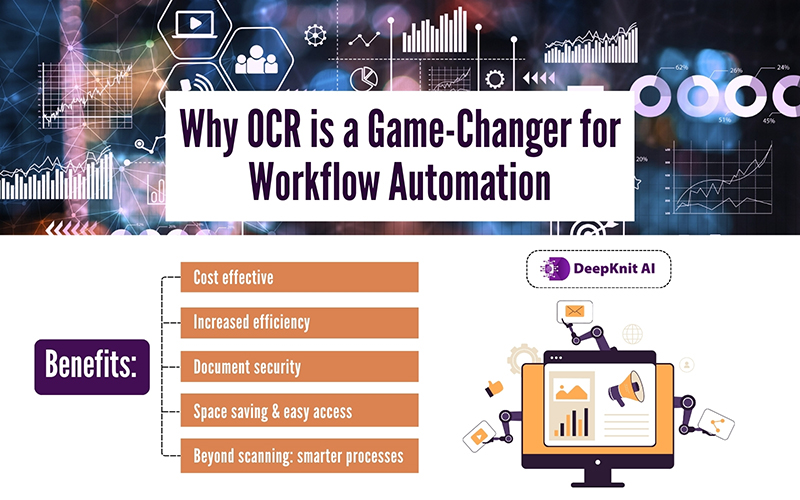Since its introduction in the early 20th century, OCR has grown to be an integral part of business processing functions. At its core, OCR works by analyzing text images in a document, identifying characters and their patterns, and converting them into machine-readable plain text that can be edited, searched, and stored as digital archives.
From being a system that could only read and digitize simple PDFs and printed texts to handwritten ones, OCR, with its integration with AI tools in recent years, has evolved from being merely a transcribing solution to a more capable data processing solution.
Further, integrating OCR with workflow automation has added advantages, and in this post, we shall look at how this can be achieved.
Benefits of Using OCR in Workflow Automation
- Cost effective: The cost of managing physical documents includes materials like paper and files, as well as additional manpower for larger volumes. All these costs can be reduced with AI OCR tools.
- Increased efficiency: Manual entry requires time and carries the risk of human error such as misinterpretations or typing mistakes. An AI OCR scans your documents and extracts all relevant data with far fewer errors, making the process more efficient and time-saving.
- Document security: Digital documents are much safer to store, as they are impervious to physical damage like fire, water, and other hazards.
- Space saving and easy access: Digital records do not require physical storage space, and with cloud-based OCR solutions, documents can be accessed from anywhere with an internet connection.
- Going beyond scanning: AI OCR tools do more than just scanning. For example, convolutional neural networks (CNNs) help OCR engines recognize patterns in poor image quality or unusual handwriting. Over time, the more you feed the OCR tool, the better it becomes at recognizing characters, layouts, and even document types, and can extract data accordingly.
Key Features to Look for in a Good OCR Tool
If you’re thinking about digitizing your document management automation process for your business, here are some of the key features you need to consider while choosing an AI OCR tool:
- Advanced features: If your business deals with different types of documents, choose an OCR tool that does more than basic text recognition. Look for advanced features like table detection, handwriting recognition, and layout analysis.
- Support for various formats: The OCR tool must be able to handle different document formats such as PDFs, image files (JPG, PNG, TIFF), and handwritten texts.
- Integration capabilities: The best OCR tool is not only one with excellent scanning capabilities and features but also one that integrates seamlessly with your existing document management automation systems or cloud platforms (such as Google Drive).
- Data security: If your business deals with sensitive documents such as medical records, legal contracts, and others, make sure that the OCR tool you choose adheres to strict data protection protocols.
- OCR APIs: Look for OCR systems that support APIs, allowing easy customization and integration into your legacy systems or apps like ERP and CRM.
Steps to Implement OCR in Automated Workflows
Now that you have chosen the right OCR tool for your business, here is a checklist for seamless integration with your existing workflow automation system:
- Pre-process input data
The quality of the input data determines the quality of the extracted data. Make sure to use high-resolution images with clear and legible text. You can also employ image pre-processing techniques such as cropping irrelevant areas, de-skewing tilted text, reducing noise, and adjusting contrast. These steps improve the OCR’s ability to recognize characters accurately.
- Leverage advanced features
Most AI OCRs come with advanced features that enhance functionality and efficiency. Utilize batch processing for handling large volumes of documents, which allows you to process multiple files simultaneously, saving time and computational resources. You can also make use of multilingual support or toggle between printed and handwritten text recognition to boost accuracy.
- Implement robust error corrections
Let’s be realistic—no automation system can deliver 100% accurate results, as they are prone to errors. The good news is that AI OCRs can learn from the corrections you make, preventing the same mistakes from recurring. Make provisions to detect and log API errors, such as network timeouts or unrecognized characters, to troubleshoot effectively and enable quick recovery.
Also, employ retry logic for temporary issues like connectivity problems, and fallback processes for handling unprocessed data manually or with alternative tools.
- Optimize for performance
Optimize OCR integration with ERP and CRM systems so it can handle workloads without delays or bottlenecks. Opt for asynchronous API calls whenever possible to enable parallel processing of other tasks, preventing your application from waiting for responses.
Also, make sure to track API response times regularly to identify and address latency issues, while adjusting workflows or scaling resources as needed to maintain optimal performance.
- Thorough testing before deployment
Comprehensive testing ensures that your AI OCR performs optimally under different scenarios and conditions. Use diverse sets of sample documents for testing and compare extracted text against expected results to verify accuracy and identify areas for improvement.
Also, involve end-users in testing to gather feedback on the system’s performance with actual documents and workflows, ensuring that the solution aligns with practical needs and user expectations.
Conclusion
In today’s competitive environment, businesses are increasingly seeking efficiency, automation, and scalability for paperless workflows. Having a robust AI OCR tool to manage your document management automation needs has become a necessity rather than a luxury.
A proper, thorough integration of an AI OCR into your workflow automation requires skilled and experienced professionals—and DeepKnit AI provides this and more to meet your diverse AI needs.
Boost your business workflow with AI OCR integration.
Consult DeepKnit AI guide for best practices.
Click here for demo.


